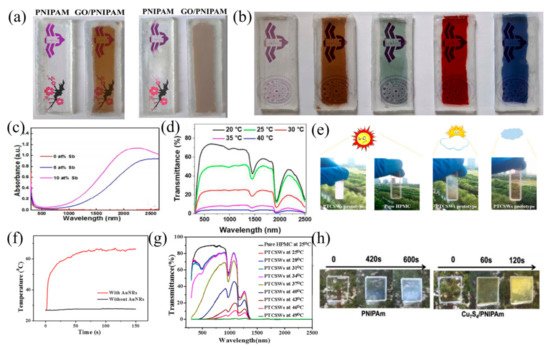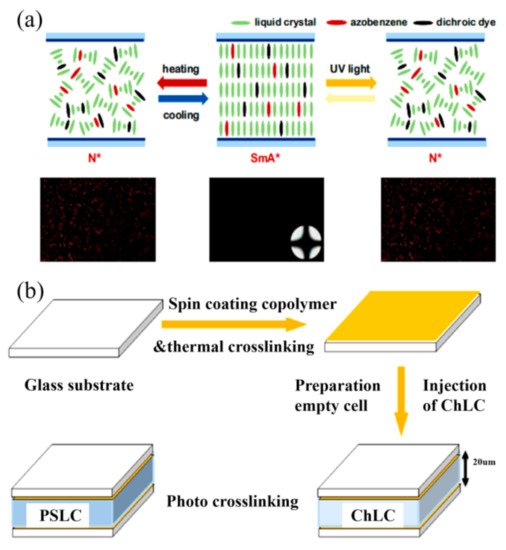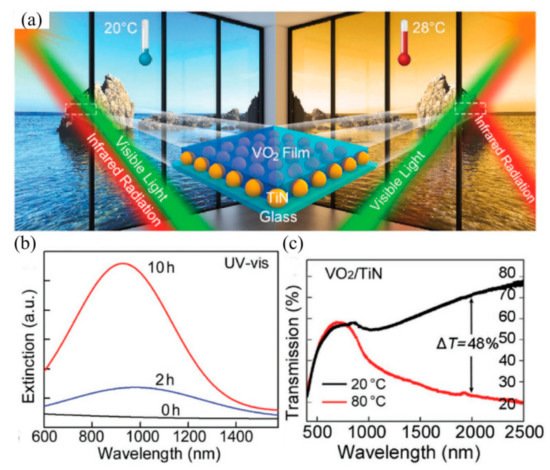You're using an outdated browser. Please upgrade to a modern browser for the best experience.
Please note this is a comparison between Version 1 by Haining Ji and Version 2 by Jessie Wu.
Thermochromic smart windows can automatically control solar radiation according to the ambient temperature. Compared with photochromic and electrochromic smart windows, they have a stronger applicability and lower energy consumption, and have a wide range of application prospects in the field of building energy efficiency. This entry describes that trends of photo-/electro-driven thermochromic smart windows.
- photo-/electro-driven
- smart windows
1. Photo-Driven Thermochromic Smart Windows
The photo-driven thermochromic smart windows can actively adjust its optical properties in response to the changes in light radiation intensity and temperature, which is a completely passive way of light modulation. Compared with the single response of the traditional thermochromic smart windows, the photo-driven thermochromic smart windows realize the dual response of light and heat. It can respond to stimulation in areas with strong light radiation and a low temperature, and can regulate the sunlight, which further expands the application range of thermochromic smart windows.
1.1. VO2-Based Smart Windows
In order to be close to practical applications, researchers usually reduce the phase transition temperature of VO2 via doping elements, but this will also lead to a decrease in its optical properties [1][2][3][17,18,19]. However, by combining VO2 with photothermal materials and using photothermal conversion, the sunlight is converted into heat energy, and VO2 can be driven to change the optical performance at room temperature. Ji et al. [4][20] designed and assembled a composite film of PbS and VO2. The UV-Vis-NIR light can be absorbed through the interaction of solar photons and PbS phonons and converted to heat energy, thus allowing for VO2 to undergo a phase change at room temperature. Subsequently, in order to further improve the optical performance of the photo-driven VO2 film, Hao et al. [5][21] prepared VO2/TiN smart coatings for room temperature applications by hybridizing thermochromic VO2 with plasmonic TiN nanoparticles (Figure 1a). The VO2 phase transition was accelerated by the strong plasma absorption in the near-infrared region of the TiN plasmonic nanoarray (Figure 1b). In addition, the VO2/TiN coating had a visible light transmittance of approximately 50% and an infrared conversion efficiency of 48% at 2000 nm, which effectively improved the optical performance of the light-driven VO2 composite films (Figure 1c).
1.2. Hydrogel Smart Windows
Hydrogels are popular materials for photo-driven thermochromic smart windows. The combination of hydrogels with graphene oxide (GO) [6][7][8][9][22,23,24,25], antimony-doped tin oxide (ATO) [10][11][12][26,27,28], CsxWO3 [13][29] and other high-absorption materials can stimulate the transformation of the optical properties of the hydrogels, thereby improving the conversion rate of the hydrogels.
GO is a common photothermal material. Under medium-intensity visible light irradiation, the fully reversible volume phase transition of the hydrogels can be triggered by the photothermal effect of GO [6][22]. Kim et al. [6][22] first studied the optical properties of hydrogels driven by the heat generated via GO. Thus, we can develop the switchable glazing of a novel photothermotropic mechanism that screens strong sunlight and heat radiation in response to the sunlight intensity, as well as the temperature. Subsequently, Kim et al. [7][23] prepared a photo-driven thermochromic smart window by using GO and poly(N-isopropylacrylamide) (PNIPAm). Lee et al. [8][24] prepared a gradient copolymer hydrogel containing GO by manipulating the monomer composition to control the hydrophilic–hydrophobic balance of the copolymer. Copolymer hydrogels exhibit different thermal behaviors according to the monomer composition. With changes in the temperature and light radiation, copolymer hydrogels can be gradually dehydrated, resulting in almost linear transmittance changes. Besides, in order to create a more comfortable and colorful life, the color change in thermochromic smart windows, such as the warm/cool-tone, is also the focus of research. As can be seen from Figure 2a,b, GO embedded within the thermotropic hydrogels can absorb the colored organic solvent, can prepare the smart glasses with arbitrary color and can further promote the development of color-tuning smart windows [9][25].
When choosing photothermal materials, it is necessary to consider its influence on the visible light transmittance of windows and to avoid materials that act on the visible light region. ATO mainly regulates near-infrared light. Compared with PNIPAm/GO film, PNIPAm/ATO film has better solar modulation in the near-infrared region [10][26]. Besides, the effect of Sb doping in ATO on its photothermal properties was also studied. The results showed that the PNIPAm/ATO film with 10% Sb doping had the best response speed and solar modulation ability [10][11][26,27] (Figure 2c). With the increase in ATO content and film thickness, the solar modulation ability and response speed will also increase [12][28]. Subsequently, a supramolecular nanocomposite hydrogel film was prepared by integrating ethylene glycol-modified pillar [14][5] arene (EGP5) and ATO [12][28]. Owing to the thermo-responsiveness of EGP5 and plasmonic heating induced by the near-infrared absorption of ATO, the film exhibited an outstanding photo-thermochromic effect, with an excellent solar modulation ability (56.1%) and initial luminous transmittance (77.2%) (Figure 2d). The dynamics and reversibility of the host–guest interaction between EGP5 and the pyridinium unit can avoid the collapse and damage of the polymeric hydrogel structure, which solved the problem of its poor durability and the repeatability of the hydrogels. Then, Wu et al. [13][29] prepared CsxWO3/PAM-PNIPAm smart windows, in which CsxWO3 was the photothermal component, PNIPAm was the optical control switch and polyacrylamide (PAM) hydrogel was the skeleton of the hydrogel matrix, so as to prevent any damage to the hydrogel structure. This smart window system was mainly heated by the near-infrared(NIR) light. While maintaining a good visible light transmittance, nearly 96% of the near-infrared light can be shielded by this window, and the indoor temperature can be maintained at approximately 25 °C. It can greatly reduce energy consumption from sources such as air conditioning and heating.
Photothermal materials, such as GO and CsxWO3, mainly use high absorption characteristics to convert light energy into heat energy. However, AuNRs and Cu7S4 used a local surface plasmon resonance effect to convert absorbed light energy into the kinetic energy of electron resonance, and then converted it into the vibration energy of the lattice through the lattice scattering of electrons [15][30]. The heat energy of lattice vibration was transmitted to the surrounding environment, thereby increasing the temperature of the environment. Cao et al. (Figure 2e,f) [16][31] prepared polyvinylalcohol/thermochromic dyes/AuNRs sunlight-responsive smart window films through combining the thermal discoloration property of the thermochromic material and the photothermal effect of AuNRs. Then, this composite material was combined with hydroxypropyl methylcellulose (HPMC) to prepare a smart window model with good optical properties. This model can achieve a stable optical performance transition under sunlight, and by controlling the content of AuNRs and the type of dye, a prototype of color smart windows with different switching temperatures can be achieved. (Figure 2g). Using a similar principle, Zhu et al. [17][32] prepared a smart window based on Cu7S4/PNIPAm hydrogel with a lower price and cost (Figure 2h). Based on the good light and heat effect of Cu7S4, this smart window can not only respond quickly at room temperature, but can also improve the indoor temperature in the cold.

Figure 2. (a) Photos of the transparency/opacity transition of PNIPAm glass and GO/PNIPAm glass before and after 5 min of sunlight. Reproduced with permission from [9][25]. Copyright 2017, Elsevier. (b) Color GO/PNIPAm glass. Reproduced with permission from [9][25]. Copyright 2017, Elsevier. (c) Ultraviolet–visible–near infrared absorption spectra of 0.025 wt% SnO2 with Sb doping content of 0, 5 and 10%. Reproduced with permission from [11][27]. Copyright 2017, American Chemical Society. (d) Transmission spectra of 5HATO films at different temperatures. Reproduced with permission from [12][28]. Copyright 2018, Elsevier. (e) PTCSWs prototype and pure HPMC in the hot summer (left), digital photos of soft sunny summer days (middle) and cloudy days (right). Reproduced with permission from [16][31]. Copyright 2018, Elsevier. (f) Temperature rise trajectory of PVA/dye film with or without AuNRs. Reproduced with permission from [16][31]. Copyright 2018, Elsevier. (g) UV-Vis-NIR spectra of PTCSWs prototype. Reproduced with permission from [16][31]. Copyright 2018, Elsevier. (h) Photos of Cu7S4/PNIPAm and PNIPAm hydrogels under real sunlight in summer (31 °C). Reproduced with permission from [17][32]. Copyright 2019, Elsevier.
1.3. Liquid Crystal Smart Windows
Liquid crystals respond to temperature stimulation by adjusting the orientation of anisotropic molecules. They show a high transparency at a low temperature and become blurred due to strong light scattering at a high temperature. They have broad application prospects in the field of smart windows. Through combining the liquid crystal polymer and the photothermal properties of CsxWO3, a flexible multi-response smart film with excellent mechanical strength was obtained [18][33]. In actual application, the transmittance of visible light through temperature and infrared light can be controlled, and 95% of near-infrared radiation in the range of 800~2500 nm can be shielded by this film. This film can achieve a mass production by using a roll-to-roll process, which had great significance in the field of smart windows.
In addition, liquid crystals are often combined with azo dyes to prepare UV-driven liquid crystal devices. Azo dye is an ultraviolet (UV) photochromic material that can change its molecular shape when irradiated by light. The trans-formed form azo derivatives is rod-shaped, which can stabilize the liquid crystal phase, whereas the cis form is curved, and when it exists, will destroy the stability of the liquid crystal phase [19][34]. Under UV irradiation, the directional alignment of liquid crystal molecules can be induced by the photoisomerization of azobenzene molecules, thereby driving its phase transition. Oh et al. [20][35] proposed a photoelectrically adjustable cholesteric liquid crystal doped with push-pull azobenzene. These liquid crystals can be stimulated by light or heat to achieve a reversible conversion between transparency and opacity. Then, Oh et al. [21][36] further doped push-pull azobenzene and chiral liquid crystals to prepare liquid crystal smart windows controlled by ultraviolet light and temperature. Under UV irradiation, the transformation of the liquid crystals, from the transparent chiral smectic phase (SmA* phase) to the opaque chiral phase sequence (N* phase), was induced by the trans-cis photoisomerization of push-pull azobenzene (Figure 3a). In addition, Kuang et al. [22][37] prepared a stable azobenzene copolymer brush, which was used as a substrate to prepare UV-driven polymer-stabilized liquid crystal (PSLC) smart windows (Figure 3b).

Figure 3. (a) Self-occlusion shutter schematic and POM images [21][36]. (b) Preparation process of polymer-stabilized liquid crystal (PSLC) smart window. Reproduced with permission from [22][37]. Copyright 2017, American Chemical Society.
2. VO2-Based Smart Windows
Due to the advantages of high transparency, high thermal conductivity and high electrical conductivity, electrothermal materials such as ITO and AgNWs have been integrated into different kinds of electro-driven thermochromic smart windows. Beydaghyan et al. [23][38] prepared VO2 films with a high transmittance and excellent thermochromic switching performance on the ITO layer. A VO2 phase transition was induced by Joule heating with ITO layer as the conductive layer. The transmittance of VO2/ITO films at 2500 nm has a reversible conversion from as high as 65% to near to zero. The particle size of VO2 deposited on ITO was smaller than that deposited on the glasses, which reduced the phase transition temperature of VO2 to a certain extent. Compared with the heating plate, the phase transition temperature of VO2 deposited on ITO is lowered by 4~7 °C. On this basis, Li et al. [24][25][39,40] studied the optical properties of VO2-based electro-driven thermochromic smart windows with AgNWs and ITO as conductive materials. The decrease in the infrared spectrum can be observed in the AgNWs/VO2 device at the voltage of 6.5–8 V (Figure 5a,b), and a further increasing of the voltage no longer leads to a decrease in the infrared spectrum. The same phenomenon was produced in ITO/VO2 devices at approximately 12.5–15 V. However, when the voltage was applied, the ITO substrate had a strong absorption rate at 2500 nm, and its infrared switching performance could be extended to near infrared regions.
In practical applications, how to reduce production costs and realize large-area heating is a problem to be considered in electric-driven thermochromic smart windows. The preparation technology of ITO has become mature, but the price is expensive. Therefore, using ITO as an electric heating device will greatly increase the preparation cost. Generally, the use of cheap and stable electrodes, such as fluorine-doped SnO2 (FTO) [26][27][41,42], Al: ZnO (AZO) [28][29][43,44], will be more conducive to the development of electrically driven thermochromic smart windows.
Both FTO and ATO were transparent conductive oxides that were easy to prepare and had a low cost. The optical constant of FTO is between VO2 and glass, and the dielectric constant is similar to VO2. Therefore, the optical performance of VO2 can be effectively improved by introducing an FTO buffer layer between glass and VO2. It has been proven that that VO2 phase transition can be driven by applied voltage on FTO/VO2/FTO multilayer films [23][38]. However, the threshold voltage also increased with the increase in the area of FTO and VO2 [26][27][41,42]. Then, Xu et al. [27][42] directly deposited VO2 on FTO glass. The experiment results showed that the rapid phase transition of VO2 in a large area can be achieved by applying a voltage below 6 V.

